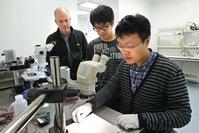Weldon BME Student's Work Attracting Attention
In a recent Lafayette Journal and Courier article, Jin Shi was lauded for first defending his Ph.D., then capping that success off with his research on a new type of nanoscale biosensor splashed on the cover of a scientific journal.
"It has been exciting," Shi was quoted as saying. "I am very happy with everything that has happened. I think I should attribute these achievements to Dr. Porterfield." Dr. Marshall Porterfield, a Professor of Biomedical Engineering and Agricultural and Biological Engineering, is Shin's advisor and research mentor.
The research team, consisting of Shi, Porterfield and Jong Hyun Choi, an assistant professor of mechanical engineering, have developed a biosensor with increased sensitivity that works in fluids. Basically, they've improved a biosensor, one so small it is measured in molecules, by replacing its conventional materials with carbon nanotubes and a new type of synthetic DNA.
Choi developed a synthetic DNA that will attach to the surface of the carbon nanotubes and make them more water-soluble. "Once the carbon nanotubes are in a solution, you only have to place the electrode into the solution and charge it. The carbon nanotubes will then coat the surface," Choi said. The electrode coated with carbon nanotubes will attract the enzymes to finish the sensor's assembly. The sensor described in the findings was designed for glucose. But Porterfield said it could be easily adapted for various compounds. "You could mass produce these sensors for diabetes, for example, for insulin management for diabetic patients," Porterfield said. "It will be a self-assembling platform for biosensors at the biomolecular level."
Shi said the biosensors are expected to be used in clinical diagnosis and monitoring beyond just glucose tests. The next step, Porterfield said, is increasing the sensitivity of the sensor so it can detect glucose levels in blood through a salvia sample.
The National Institutes of Health and the Office of Naval Research funded the research, which will appear as the cover story in the December 2011 edition of the journal The Analyst.


